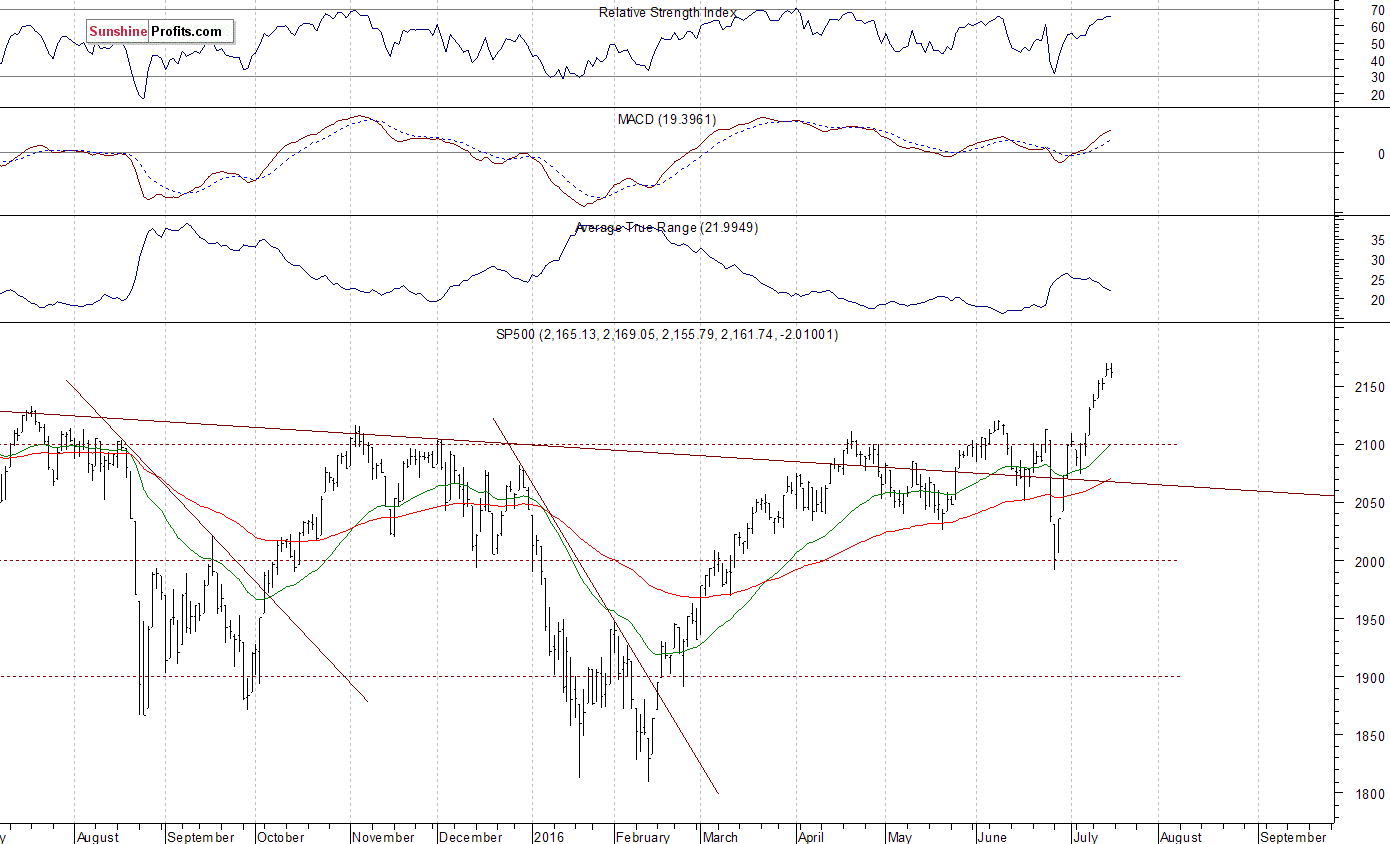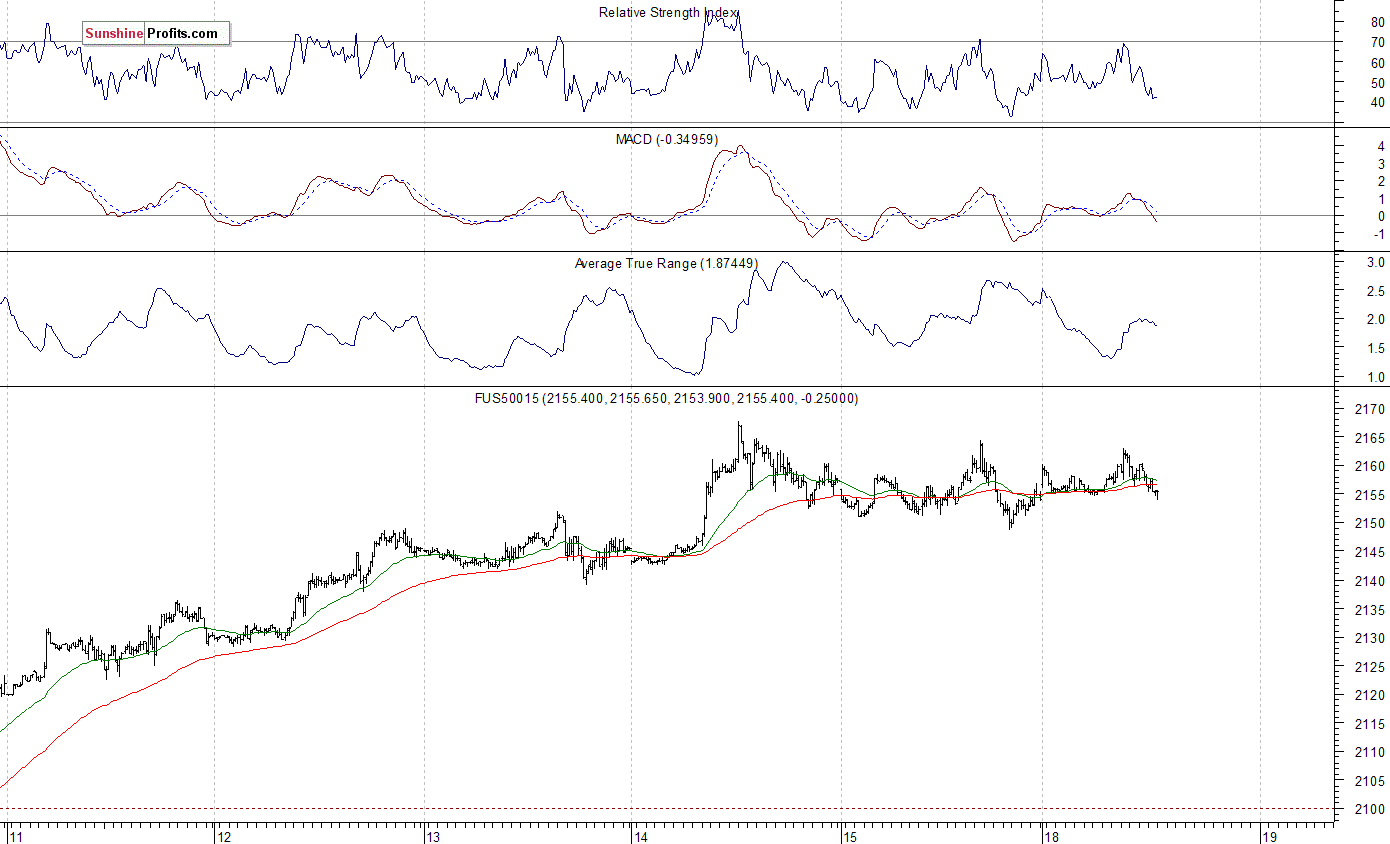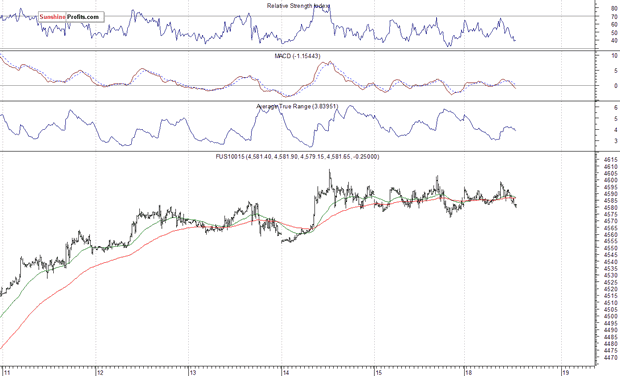Stocks & Equities

Traders work at their desks in front of the German share price index, DAX board, at the stock exchange in Frankfurt, Germany, July 20, 2016.
World stocks faded after hitting nine-month highs on Thursday, cooled by signals from Japan that its next shot of stimulus won’t include hand-out ‘helicopter money’.
The European Central Bank, at its first post-Brexit meeting, opted to keep its record low interest rates on hold and Wall Street markets looked to be heading for a subdued restart.
There were roller coaster moves for the yen in the currency markets. It fell to a six-week low on reports of a 20 trillion plus yen Japanese stimulus package only to bolt up as Bank of Japan chief Haruhiko Kuroda shot down talk of the extreme “helicopter money” option — effectively giving cash directly to the population — in a BBC radio interview.
Europe’s main bourses had turned lower as the news compounded what had already been a subdued start after warnings of poor bookings from Lufthansa (LHAG.DE) and easyJet (EZJ.L) had sent airline stocks tumbling. .SXTP
The German firm dropped over 7 percent as it said bookings had been hit hard by the recent “terrorist attacks in Europe and greater political and economic uncertainty,” mainly meaning Britain’s vote to leave the European Union.
It left the pan-regional FTSEurofirst 300 .FTEU3 down 0.5 percent and dragged MSCI’s 46-country All-World share index .MIWD00000PUS back towards the red after it had hit its highest level since early November in Asia.
Focus then turned to the ECB’s meeting in Frankfurt and its list of concerns including the impact of Brexit, a potential Italian banking crisis and suggestions the central bank itself is running out of policy ammunition.
Having held its rates, Mario Draghi used a news conference to stress the bank was committed to its 80 billion euros ($88 billion) a month stimulus programme and would use “all available instruments,” if things took another turn for the worse.
It left the euro a touch higher at $1.1060 EUR= having fallen for 10 of the last 14 weeks, while German DE10YT=TWEB and other core euro zone government bond yields nudged up to their highest levels of the month so far. [GVD/EUR]
“This month is all about central banks sitting on their hands and the ECB is no exception,” said Aberdeen Asset Management’s Luke Hickmore.
“They are waiting for some hard economic data to indicate what harm the UK’s referendum might have on euro zone growth.”
Turkish assets struggled again after President Tayyip Erdogan declared a state of emergency on Wednesday, widening a crackdown against thousands of members of the security forces, judiciary, civil service and academia after Friday’s failed military coup.
Istanbul’s main stock market slumped 3.3 percent .XU100 in a fourth day of falls, although the lira TRY= managed to claw back 0.25 percent after plunging below the big figure of 3 per dollar.
Turkey apart, emerging markets are on a hot streak. Inflows to EM assets hit their highest level in nearly three years last week, according to the latest survey by the Institute of International Finance.
For Reuters new Live Markets blog on European and UK stock markets see reuters://realtime/verb=Open/url=http://emea1.apps.cp.extranet.thomsonreuters.biz/cms/?pageId=livemarkets
BIG IN JAPAN
Futures prices ESc1 pointed to a steady start for record high Wall Street markets .SPX.DJIwhen they resume later having already received some mixed Philly Fed data. ECONG&
Overnight, MSCI’s broadest index of Asia-Pacific shares outside Japan .MIAPJ0000PUS had risen to its highest level since October 2015, taking gains over the last month past 10 percent in the process.
Japan’s Nikkei stock index .N225 outperformed as it rose 1 percent on reports that the government is to compile a stimulus package of at least 20 trillion yen to help the economy.
“What the market wants now is both fiscal and monetary policy and such expectations are getting higher,” said Hikaru Sato, a senior technical analyst at Daiwa Securities.
Having been as low as 107.46 to the dollar, the yen was spurred right back up to 105.71 by Kuroda’s comments in a BBC radio interview when he said: “I don’t think at this stage we should abandon this intuitional setting. No need and no possibility for helicopter money.”
The dollar index, which tracks a basket of six main world currencies, dipped to 96.870 .DXY having touched 97.323, its highest level since early March, on Wednesday.
In commodity markets, oil was beginning to wobble again. Brent crude LCOc1 nudged back towards $47 a barrel having been as high as $47.35 in Asia, while U.S. crude CLc1 was a touch higher at $45.84 a barrel.
The more uncertain hue gave a boost to safe-haven gold XAU=, which edged up 0.3 percent to $1,320 an ounce after plumbing three-week lows on Wednesday. U.S. government bond yields ticked lower to 1.5732 percent US10YT=RR following a near 20 percent rise since the start of the month.
“With gold looking increasingly shaky on the charts, all eyes will turn to the ECB policy meeting,” said INTL FCStone analyst Edward Meir.
“Should the central bank signal a more accommodative policy, we could see gold get a bit of a lift despite the fact that the dollar could strengthen as a result.”
($1 = 0.9076 euros)
(Addition reporting by Saikat Chatterjee in Hong Kong, Vijaykumar Vedala in Bengaluru; Editing by Catherine Evans/Ruth Pitchford)
related:
Technically Speaking: Pushing Extremes

Included in this issue: Strategy of the Week and Two Stocks that meet that strategy

![]()
In This Week’s Issue:
– Stockscores’ Market Minutes Video – How to Play a Slow Summer Market
– Stockscores Trader Training – Good Traders Are Fussy
– Stock Features of the Week – Long Term Reversals
Stockscores Market Minutes Video – How to Play a Slow Summer Market
Many traders find the summer months a frustrating time to trade. This week, I discuss a few simple things to keep in mind when trading a slow summer market. Click Here to Watch To get instant updates when I upload a new video, subscribe to the Stockscores YouTube Channel
Trader Training – Good Traders Are Fussy
Traders, particularly those who need to make money rather than those who would like to make money, tend to have a fear of missing out. They hear about a trading idea or find an opportunity with their own effort and make the trade with less thought than they might put into buying a microwave. They can invest thousands of dollars on an impulse, much like the drunken gambler who throws down $1000 on Five Red.
One reason for this sort of reckless approach to trading is the belief that trading ideas are like gifts. They only come along from time to time and you should feel grateful for the opportunity. If you spend 10 hours researching a company or receive the occasional bit of insight from someone who should know more than the rest of us, it’s easy to understand why you wouldn’t want to let a seemingly promising trade slip through your fingers. The problem is that this gratitude for trading ideas leads you to lower your standards and place trades that are not much more than a gamble.
Have you ever made a trade and then, just a few minutes or days later, asked yourself what the heck you were thinking? If you are normal, then it’s likely that you have because it is easy to focus on the dream of making a profit. You should focus your attention on the trading situation as it has been presented to you by the market rather than the words of an expert. Some trading opportunities are so well marketed that it’s hard to see the truth because you fixate on the profit potential that has been dangled before you as the prize.
It is critical to only take trades that meet the criteria of a strategy that you have found to have a positive expected value. Rather than look for a reason to take the trade, which is easy, look for a reason not to. Ask yourself, “If I buy this stock, who will be selling to me, and what does she know that I don’t know?” Looking at the other side of the argument will often highlight considerations that you have missed.
Being fussy is a lot easier when you recognize that the market-even a slow market-will give you opportunities. The markets have been pretty quiet this year but there are still stocks outperforming the market every day.
And if you can’t find a trade today, tomorrow or in the next week, eventually you will. There is always another bus coming down the road. If you miss one, just wait for the next.
I have found that you will actually make more money by trading less. If you maintain a very high standard for what trades you make, you will always pass on some trades that end up doing very well. By being selective, however, you will also avoid many marginal trades that would tie up your capital and then incur a loss. By being fussy and trading less, you end up taking only the very best trades and your results will be better overall.
It is easy to be fussy when the market is strong and there are lots of opportunities. It’s like fishing when every time you cast your line you get a bite. With that kind of success, you will quickly throw back any fish that is too small because you know there’s going to be something better coming along soon. You only take the best of the best.
When the fish stop biting and you spend hours with no bounty, you take the first fish that grabs your hook. It could be a tiny fish that you would never keep on even an average day, but with your desire to catch something, you keep it anyway. It would be better to have just not gone fishing at all.
You’ll do the same thing when trading a slow market. Eager to make a profit, you will take trades that show some potential even if they don’t meet all of your requirements. You will work hard to uncover a trade rather than wait for the obvious no-brainer trades that you take when the market is in a giving mood.
I like to say that in trading, when the going gets tough, the tough get lazy. You can’t control the market, so if the market is not giving you opportunities, it’s better to do nothing. Your hard work will not change what the market does.
This is hard for many people who have been programmed to relate hard work to success. If you try harder than the next person in a sport, you should get a better result. If you study harder for an exam, you should get a better mark. If you work longer hours at your job, you should make more money. In the stock market, if you work harder to find good trades, you will probably lose money.
The best trades are easy to find. Working hard to uncover something leads you to find questionable trades that you have to talk yourself into. It’s better to walk away when you have doubts.
This is not to say that hard work is not rewarded in trading. Traders who work hard at practicing their analytical skills or developing new strategies will be rewarded. People who devote their time and effort to improving their emotional control will be better traders. These are things that you can control and affect with hard work, but hard work won’t change what the stock market does.
This week, I decided to take two of the picks sent to me by one of my students. Both show good long term turnaround charts, the kind of picks you would focus on with the Stockscores Simple Weekly strategy. This strategy looks for stocks where the anticipated hold period is measured in months or even years.
1. HSC
HSC has broken the downward trend line and is now making an abnormal break to the upside from a rising bottom. Support at $5.90.
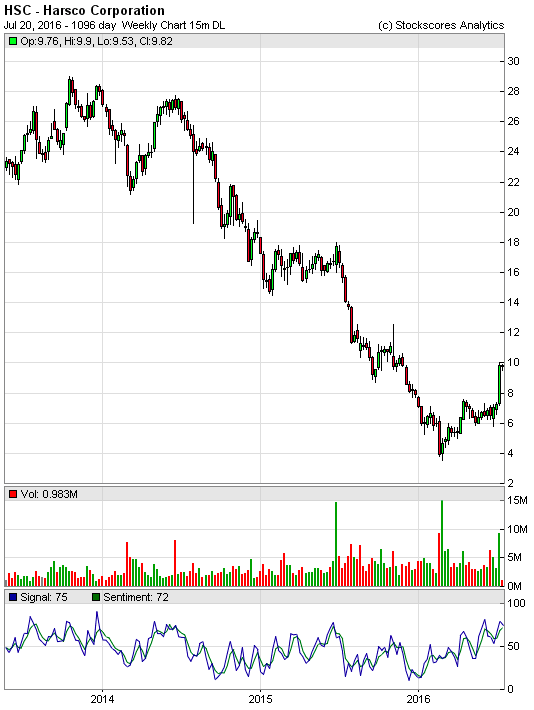
2. ARLP
ARLP has a similar chart pattern to HSC, as it is now breaking up from a rising bottom after breaking the long term downward trend line. Support at $14.
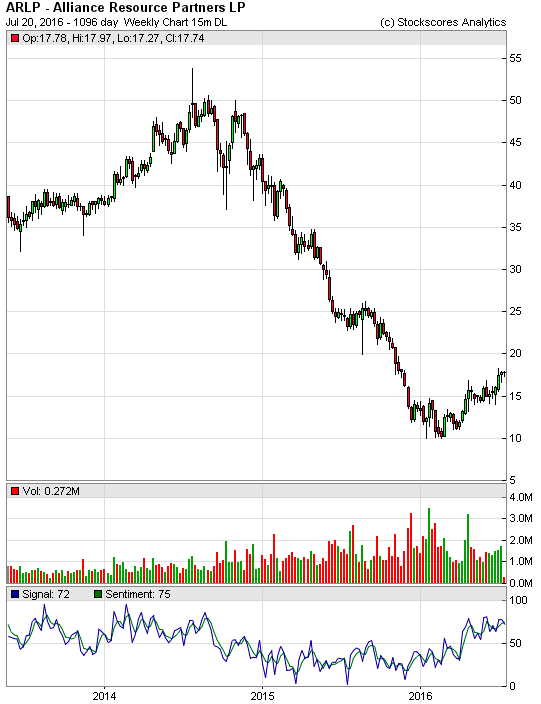
related: Critical Inflection Point
References
- Get the Stockscore on any of over 20,000 North American stocks.
- Background on the theories used by Stockscores.
- Strategies that can help you find new opportunities.
- Scan the market using extensive filter criteria.
- Build a portfolio of stocks and view a slide show of their charts.
- See which sectors are leading the market, and their components.
Disclaimer
This is not an investment advisory, and should not be used to make investment decisions. Information in Stockscores Perspectives is often opinionated and should be considered for information purposes only. No stock exchange anywhere has approved or disapproved of the information contained herein. There is no express or implied solicitation to buy or sell securities. The writers and editors of Perspectives may have positions in the stocks discussed above and may trade in the stocks mentioned. Don’t consider buying or selling any stock without conducting your own due diligenc

We are entering the heart of earnings season, and it may be a wild one because Wall Street’s own outlook is quite poor.
The consensus Wall Street estimate for Q2 profits of the S&P 500 is that they will fall by 5.6% on a year-over-year basis. That would be, by the way, the fifth quarter in a row of falling corporate profits.
The retail industry is particularly vulnerable, as evidenced by a parade of retailers that previously reported disappointing results and/or are warning that the rest of the year will be even worse. In the month of May, retail sales shrunk by 3.9%, worsening from a 2.9% drop in April.
Moody’s Investors Service not only lowered its estimates for 2016 retail sales, but also its outlook for the industry as a whole from “positive” to “stable”:
“We have scaled back our growth and outlook expectations for the US retail industry primarily due to weakness in four sub-sectors: apparel and footwear, discounters and warehouse clubs, department stores and office supplies.”
Bank of America, which knows a thing or two about credit card usage, said its aggregated data of Bank of America debit cards and credit cards showed particular weakness in four retail areas:
- Department stores: down 4.0%
- Teen/young adult stores: down 4.6%
- Home goods: down 3.6%
- Electronics: down 3.0%
There are many places to point your finger for the discouraging retail results, but one of the more surprising culprits may be that a growing number of Americans just can’t afford it.

According to America’s Research Group (ARG), more than 20%, or 26 million Americans, are simply too poor to shop.
We all know about the 47% of Americans that are on the receiving end of government benefits, but ARG estimates that there are another 26 million Americans that are largely overlooked by politicians: the working poor.
These working poor work an average two to three jobs and pull in less than $30,000 of annual income.

Even those fortunate enough to make more than that are struggling. Nearly half of all Americans have not seen an increase in salary over the last five years, and another 28% have seen their take-home pay reduced by higher medical insurance deductions.
As a result, “The poorest Americans have stopped shopping, except for necessities,” said Britt Beemer of America’s Research Group.
It gets worse—even finding money to pay for necessities is a struggle. 47% of Americans wouldn’t be able to come up with $400 to pay for a doctor visit without reaching out to friends.
Not only are 26 million Americans too poor to shop, two-thirds of Americans have essentially zero savings.
That gloomy news doesn’t mean you need to bury your head in the investment sand and give up on all retailers. In fact, there are several opportunities connected with cash-strapped American consumers.
Specifically, I’m talking about discount retailers, which are doing very well.
For example, the stock of Dollar General (NYSE:DG) has been on fire thanks to strong profit growth. In the last quarter, Dollar General beat the pants off Wall Street’s expectations of $0.94 of profit by delivering $1.03 per share.

That was 22% above last year’s first quarter—and the fifth quarter in a row that Dollar General exceeded forecasts, which tells me there are big profits to be made from catering to cash-strapped Americans.
Oh, and for you dividend lovers, Dollar General pays a $1.00 annual dividend.
Other discount retailers that enjoy strong business by serving penny-pinching Americans include: Dollar Tree (DLTR), Big Lots (BIG), TJX Companies (TJX), Wal-Mart (WMT), and Costco (COST).
That doesn’t mean you should rush out and buy any of these stocks tomorrow morning. As always, timing is everything, but discount retailers are one of the few bright spots in the retail industry and worthy of your consideration.

Tony Sagami![]()
also:
The state of the markets at these All Time Highs

Since the Institutional Investors are the largest stock owner group (owing over half), when they sell, they put tremendous downside pressure on the market.
When the don’t sell, the lack of their selling takes pressure off of the market and allows it to go higher on retail buying (even if Institutions are buying very little).
So, what are they doing now? If you look at today’s posted chart, Institutional Investors were still in a selling down trend at the close yesterday which has been a market positive.’
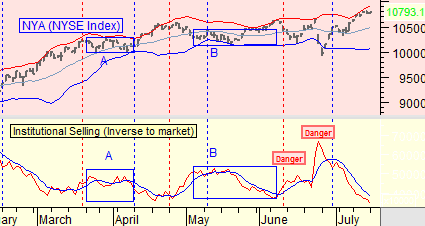
related:
Stock Trading Alert: Stocks Remain At All-Time High, Will They Continue Even Higher?
About Marty Chenard:
Marty is an Advanced Stock Market Technical Analyst that has developed his own proprietary analytical tools and stock market models. As a result, he was out of the market two weeks before the 1987 Crash in the most recent Bear Market he faxed his Members in March 2000 telling them all to SELL. He is an advanced technical analyst and not an investment advisor, nor a securities broker.

Stock Trading Alert originally sent to subscribers on July 18, 2016, 6:51 AM.
Briefly: In our opinion, speculative short positions are favored (with stop-loss at 2,210, and profit target at 2,050, S&P 500 index).
Our intraday outlook is now bearish, and our short-term outlook is bearish. Our medium-term outlook is now neutral, following S&P 500 index breakout above last year’s all-time high:
Intraday outlook (next 24 hours): bearish
Short-term outlook (next 1-2 weeks): bearish
Medium-term outlook (next 1-3 months): neutral
Long-term outlook (next year): neutral
The U.S. stock market indexes were virtually flat on Friday, as investors hesitated following recent rally. The S&P 500 index has managed to reach yet another new all-time high at the level of 2,169.05. The nearest important level of support is at around 2,130-2,135, marked by previous level of resistance (S&P 500 index). The next important level of support is at around 2,100-2,120. On the other hand, potential level of resistance is at 2,200 mark. There have been no confirmed negative signals so far. However, we can see some short-term overbought conditions accompanied by negative technical divergences:
Expectations before the opening of today’s trading session are virtually flat, with index futures currently up 0.1%. The European stock market indexes have been mixed so far. Investors will now wait for the NAHB Housing Market Index release at 10:00 a.m. The S&P 500 futures contract trades within an intraday consolidation, as it fluctuates along the level of 2,150-2,160. The nearest important level of resistance is at around 2,160-2,165, marked by recent all-time high. On the other hand, support level is at 2,150. There have been no confirmed negative signals so far. However, there are some technical overbought conditions, as we can see on the 15-minute chart:
The technology Nasdaq 100 futures contract follows a similar path, as it currently trades within an intraday consolidation along the level of 4,580-4,600. The nearest important level of resistance is at around 4,600-4,610. On the other hand, support level remains at 4,550-4,570, marked by short-term consolidation, as the 15-minute chart shows:
Concluding, the broad stock market remains close to its all-time high, as the S&P 500 index continues to trade above 2,150 mark. We still can see short-term overbought conditions accompanied by bearish technical divergences. Therefore, we decided to open a speculative short position at the opening of today’s cash market trading session (S&P 500 index). Stop-loss level is at 2,210 and potential profit target is at 2,050 (S&P 500 index). You can trade S&P 500 index using futures contracts (S&P 500 futures contract – SP, E-mini S&P 500 futures contract – ES) or an ETF like the SPDR S&P 500 ETF – SPY. It is always important to set some exit price level in case some events cause the price to move in the unlikely direction. Having safety measures in place helps limit potential losses while letting the gains grow.
Thank you.
related:
Michael Campbell’s commentary on The Dominant Driver of Capital World Wide



